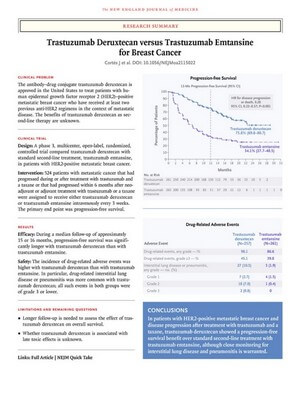Author(s): Javier Cortés, M.D., Ph.D., Sung-Bae Kim, M.D., Ph.D., Wei-Pang Chung, M.D., Seock-Ah Im, M.D., Ph.D., Yeon Hee Park, M.D., Ph.D., Roberto Hegg, M.D., Ph.D., Min Hwan Kim, M.D., Ph.D., Ling-Ming Tseng, M.D., Vanessa Petry, M.D., Chi-Feng Chung, M.D., Hiroji Iwata, M.D., Ph.D., Erika Hamilton, M.D., et al., for the DESTINY-Breast03 Trial Investigators*
Author Affiliations
From the International Breast Cancer Center, Quirónsalud Group, Barcelona, the Scientific Department, Medica Scientia Innovation Research, Valencia, and the Department of Medicine, Faculty of Biomedical and Health Sciences, Universidad Europea de Madrid, Madrid — all in Spain (J. Cortés); Asan Medical Center, University of Ulsan College of Medicine, Ulsan (S.-B.K.), Seoul National University Hospital, Cancer Research Institute (S.-A.I.), and Seoul National University Bundang Hospital (J.H.K.), Seoul National University College of Medicine, and Samsung Medical Center (Y.H.P.), Seoul, and Severance Hospital, Yonsei University, Yonsei (M.H.K.) — all in South Korea; the Department of Oncology, National Cheng Kung University Hospital, College of Medicine, National Cheng Kung University, Tainan (W.-P.C.), and the Department of Surgery, Taipei Veterans General Hospital, College of Medicine, National Yang-Ming Chiao Tung University (L.-M.T.), Koo Foundation Sun Yat-Sen Cancer Center (C.-F.C.), and National Taiwan University Hospital and National Taiwan University College of Medicine (C.-S.H.), Taipei — all in Taiwan; Clínica de Pesquisas e Centro de Estudos em Oncologia Ginecológica e Mamária (R.H.) and Instituto do Câncer do Estado de São Paulo Octavio Frias de Oliveira (V.P.), São Paulo, and Hospital Nossa Senhora da Conceição, Porto Alegre (J.L.P.) — all in Brazil; Aichi Cancer Center Hospital, Aichi, Japan (H.I.); Sarah Cannon Research Institute, Tennessee Oncology, Nashville (E.H.); the Department of Oncology and Hematology–Oncology, University of Milan, and the Division of Early Drug Development, European Institute of Oncology, Istituto di Ricovero e Cura a Carattere Scientifico — both in Milan (G.C.); the Cancer Hospital, Chinese Academy of Medical Sciences and Peking Union Medical College, Beijing (B.X.); the University of Hong Kong, Hong Kong (J.W.Y.C.); Daiichi Sankyo, Basking Ridge, NJ (C.L., Y.L., J. Cathcart, E.B.); AstraZeneca, Gaithersburg, MD (S.V.); and the David Geffen School of Medicine and Jonsson Comprehensive Cancer Center, University of California, Los Angeles, Los Angeles (S.A.H.).

